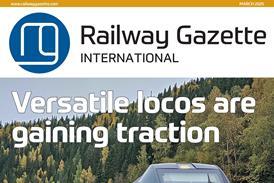
BRAKING: An Inertia Dynamometer Test Rig now installed at Knorr-Bremse’s München plant can simulate extreme environmental conditions found in the hottest and coldest parts of the world, allowing the brake manufacturer to reproduce any requirements a high speed train operator may envisage.
Knorr-Bremse has made a significant investment in the 60 tonne rig, which can rotate 12 tonne loads at 3000 rev/min, equivalent to 890 mm diameter wheels on a German ICE high speed train travelling at 500 km/h.
Software automatically applies the brake to simulate maintaining a constant speed on a gradient. When emergency braking is triggered the brake has to transform the kinetic energy of the 8·7 tonne flywheel into heat. Temperature sensors are attached to the disc, with a video camera for visual monitoring. The disc temperature peaks at 750°C, heat which has to be dissipated as evenly as possible through a combination of the brake disc and pads.
Recent work has focused on developing brakes for East Japan Railway. Gradients in central Japan impose high braking requirements, and during an earthquake trains must be brought to a stand from 320 km/h within 4 km.
‘In this scenario, every individual brake disc with its brake pads has to transform 50 MJ of energy into heat. That is the equivalent of 15 sports cars with 60 brake discs simultaneously coming to a halt from a speed of 250 km/h,’ said Dr Michael Michaelis, head of high speed testing at Knorr-Bremse.




















